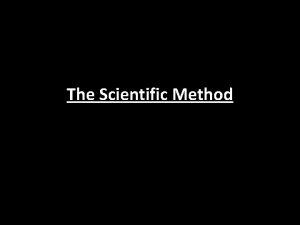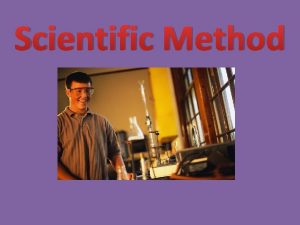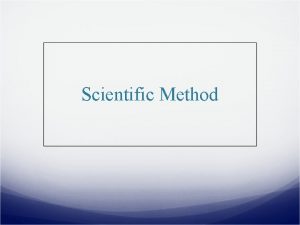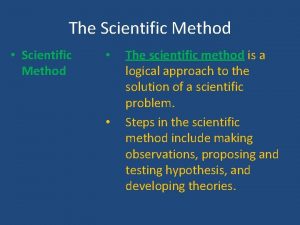Scientific method Scientific Method The method you use











- Slides: 11

Scientific method

Scientific Method • The method you use for conducting scientific research/experiments. • Allows experiments to be duplicated and communicated uniformly. • Contains observation/research, hypothesis, prediction, experimentation, conclusion

Scientific Method Steps 1. Observation/Research – Gathering information on the topic of interest • Eg. I want to know which paper plane flies farther: one with wide wings or one with short wings. First I would gather facts/information about paper planes

Scientific Method Steps 2. Hypothesis – An educated guess. A suggested explanation for the answer you think you will find. – Eg 1. Paper planes with wider wings fly farther than paper planes with shorter wings – Can you think of another example of a hypothesis?

Scientific Method Steps 3. Prediction – what you think will happen. – Eg 1. The plane with wider wings will fly 1 meter farther than the plane with a shorter wing span.

Scientific Method Steps 4. Experiment – the tool you invent to answer the question • • • Must be reproducible Must be quantifiable Must keep all variables the same except for one. – Eg. An experiment was designed using one plane with a wing span of 5 cm and another plane with a wing span of 10 cm. The ONLY difference between paper airplanes is the wing span. Eg they were both folded the same way and made of the same paper.

Scientific Method Steps 5. Conclusion – summary of the experiments results. You can not PROVE your hypothesis, you can only find results that support or refute the hypothesis. – Eg. “it was found that the plane with the wider wing span flew farther than the plane with the shorter wing span”


Theories and Laws • An observation is something that is witnessed and can be recorded, and a theory is an interpretation, or a possible explanation of why nature behaves in a particular way. • Remember that theories are human inventions. • Laws – have been proven. Ie. The conservation of mass – total mass of materials before and after the change is the same. • Law – tells what happens. • Theory – attempts to explain why it happens. ***Theories do not become Laws

Paper Airplane Experiment • Research/Observations – think about your knowledge on how planes fly and past times you’ve made paper airplanes. • Hypothesis – state your hypothesis. Eg. “planes with less weight fly farther distances” • Experiment – write down how you will test your hypothesis. Everyone will use distance flown as the measurement. Do 3 trials for each plane. • Once you finish this part, show it to me, and I will give your paper to make the airplanes and conduct your experiment. • Analyze your data – “plane A flew 4. 5 meters and plane B flew 3 meters” • Conclusion

Experiment Data Table Trial 1 Distance flown Plane A Plane B Trial 2 Distance flown Trial 3 Distance flown




















